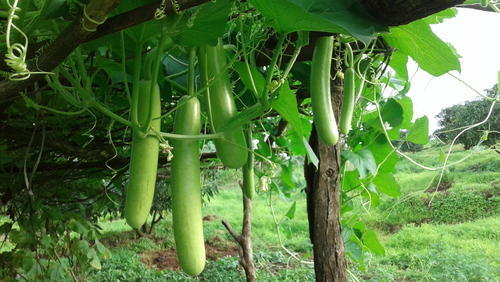أنس بن مالك يقول إن خياطا دعا رسول الله صلى الله عليه وسلم لطعام صنعه قال أنس فذهبت مع رسول الله صلى الله عليه وسلم فرأيته يتتبع الدباء من حوالي القصعة قال فلم أزل أحب الدباء من يومئذ
ʾAnas said, “A tailor invited Allāh’s Messenger صلى الله عليه وسلم for a meal which he had cooked. So I went with Allāh’s Messenger صلى الله عليه وسلم and saw him plucking the dubbāʾ from around the edges of the platter. So I always loved dubbāʾ since that day.” [Chapter of plucking from the edges of a platter if your companion does not dislike it].
Reliable contemporary dictionaries, such as Almaany, suggest both “pumpkin” and “gourd” as English translations for dubbāʾ. Both are scientifically fruits (having seeds). They are botanically related, both are under the classification of Cucurbita, yet they are obviously distinct fruits. In seeking to be as close to the Sunnah as possible, which of the two would be the better translation?
In their commentaries on the above narration, giants of the science of Ḥadīth, such as ʾIbn Ḥajar and ʾān-Nawawī (Allāh’s mercy be upon them both), discuss issues of etiquette, Sunnah, the correct pronunciation of dabbāʾ yet contrary to their usual attention to detail, neither ʾImām makes an effort to clarify which fruit is applicable to the Ḥadīth. This is not surprising when one considers that in that time and place only one of the two fruits existed. There was no need to clarify between a known fruit and one which the Arabs heard never seen to that point.
The Tree of Yūnus (peace be upon him)
Before turning to the historical evidence, we do have access to a detailed description in the Islāmic sources, which provide further clarity. In his commentary, ʾIbn Ḥajar narrates from Nasāʿī that Allah’s Messenger (صلى الله عليه وسلم) said, “It is the tree of my brother, Yūnus.”
The Qurʾān uses the synonym yaqṭīn in ʾāṣ-Ṣāfāt:146, “And We made a Yaqṭīn tree grow over him [Prophet Yūnus peace be upon him].”
ʾIbn Kathīr describes the tree as follows in his commentary:
“It grows quickly. It gives shade due to its large leaves and that it rises. Flies tend to stay away from it. Its fruit is excellent nutrition wise. It is eaten raw and cooked, the flesh and shell is also edible. It is an established fact that Allah’s Messenger (صلى الله عليه وسلم) loved dubbāʾ and plucked it from the edges of the platter.”
From this description is would be clear that the tree which “rises" and is shady, must be bottle gourd (calabash/ Lagenaria siceraria) which grows as a vine, not pumpkin which grows on the ground and does not give shade.
 |  |
In regards the shell, calabash is not normally edible, but can be eaten when the fruit is still young.
Historical Origins
Calabash originated in Africa and reached Asia thousands of years ago. It would not have been an alien to the Arabs, as opposed to pumpkin which originated in Central America and was only recorded by the “Old World” in 1584, a millennium after Allāh’s Messenger صلى الله عليه وسلم. It would therefore seem more likely that he ate bottle gourd and not pumpkin.
May Allāh guide us to the Sunnah, in its love, knowledge and implementation.
سليمان الكندي
@sulayman_kindi
